A Pro Chef Shares 9 Tips For Picking Out The Perfect Watermelon
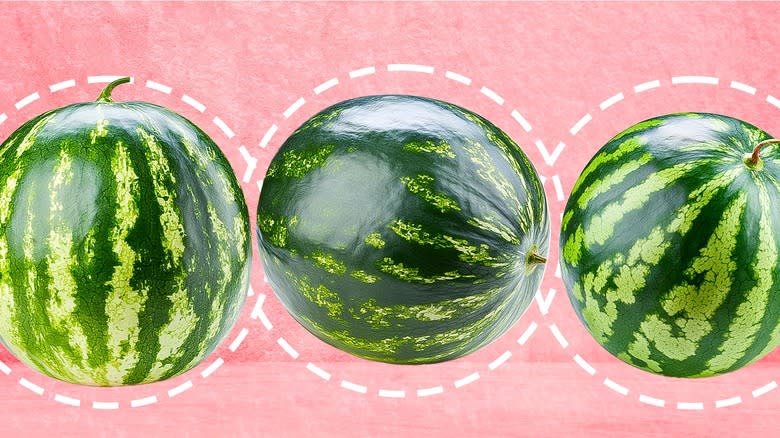
Nothing signals summer's arrival more than pushing your shopping cart past a mountain of watermelons in your grocery store's produce section. When the melons arrive, you know it's the season of no school, vacations, and endless weekend barbecues. Those barbecue spreads wouldn't be complete without fresh watermelon. Whether you're whipping up a melon fruit salad, pouring ice-cold glasses of watermelon lemonade, or staying cool with a serving of watermelon granita, everyone's favorite melon is the MVP of summer fruit.
Though watermelon is often available year-round, its season runs from May through September, just in time to make all of our summer celebrations delicious. One bite of watermelon should give your taste buds a burst of flavor that's both sweet and refreshing, and you'll only achieve that with a melon that's perfectly ripe. Unfortunately, choosing a perfect watermelon can be tricky. It's much more involved than simply grabbing one from the top of the pile.
As a personal chef, I spent years honing my ability to choose the ripest, sweetest melons to use in recipes for my clients, while also learning how to pick camera-ready melons with the brightest, most gorgeous flesh for food-styling gigs. I made friends with the staff in my grocery store's produce department, and asked tons of questions to producers at farmer's markets to get the inside track on how to choose a great watermelon. These tips will give you a step-by-step roadmap to picking the perfect watermelon every time.
Read more: 13 Simple Tricks To Pick The Best Fresh Fruit Every Time
Pick Up The Watermelon
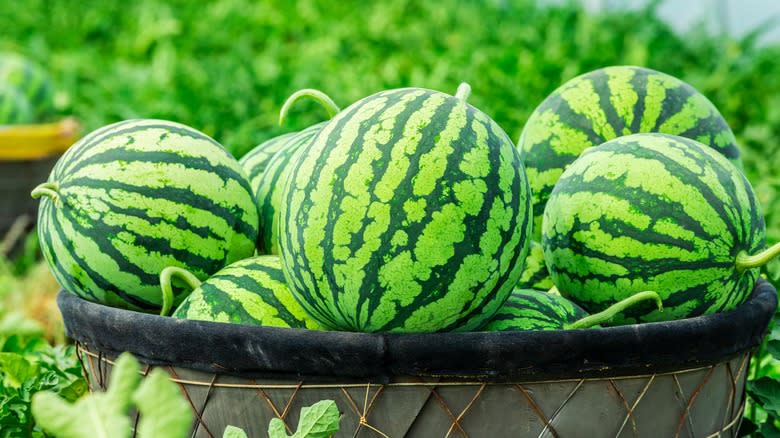
Even though there are more than 1,200 varieties of watermelon, their sizes can be grouped into just a handful of categories. Mini melons are the small, personal-sized option perfect for a healthy snack. Picnic melons are at the other end of the size spectrum — they're the giant melons that can easily feed a crowd. Cannonball melons (also known as icebox melons) are right in the middle, more than enough for one person but still small enough to fit in the fridge.
No matter what size your melon is, one of the easiest ways to determine if it's ripe is to pick it up and pay close attention to its weight. It should feel dense and heavy for its size. Fruit typically weighs more when it's ripe, and watermelon is no exception.
One reason that watermelons are so much heavier than they look is that they're about 92% water. Ripe melons contain more water and more sugar, which is just the balance you're looking for. Pick up several melons that appear to be around the same size, and choose the one that feels heaviest.
Find The Field Spot
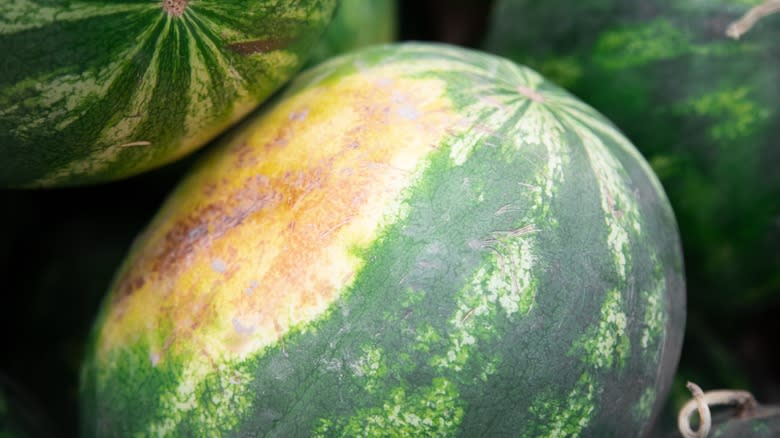
There's more to the rind of a watermelon than meets the eye. Watermelon rinds can differ in color from pale to bright green, with consistent coloration all around or varying shades of green. Since the flesh of the fruit isn't visible until you cut it, the watermelon's skin holds the secrets to the level of ripeness inside.
When you're checking out the skin of a watermelon, there are many clues to look for on its surface. If you've ever passed over a melon because of a patch or spot on its surface, you may have missed out on a good one. That apparent discoloration was likely the melon's field spot, which is one of the first things you should look for when selecting a ripe melon.
The field spot (or ground spot) is a patch of yellow skin that develops as the melon lays on the ground while it grows on the vine. Field spots can range from pale yellow to a more intense yellow or orange color. The yellow color intensifies as the melon ripens, so choose one with the most intensely yellow field spot you can find. When watermelons have no field spot, a small spot, or a spot that is white in color instead of yellow, this likely means the melon was harvested before it had a chance to ripen fully.
Measure The Watermelon's Stripes
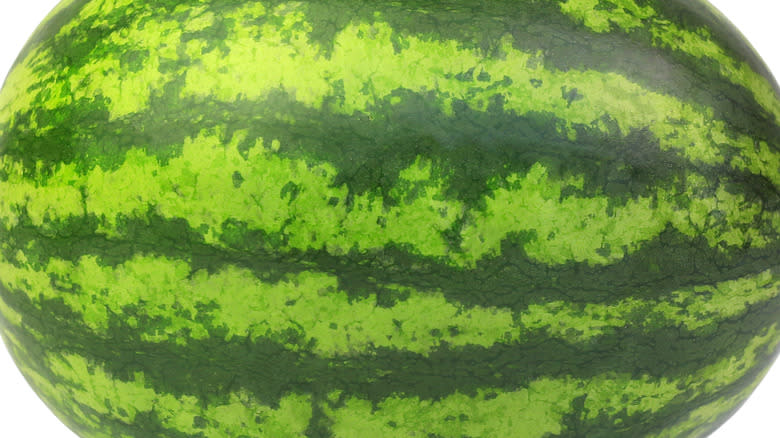
There's no mistaking watermelon for any other melon. Their green, striped rind sets them apart from all other fruits. Many believe those stripes are more than just a pretty pattern, and that they are a good indicator of the melon's ripeness. Conversely, there are also those who believe a melon's stripes have no bearing on the fruit's ripeness.
The National Watermelon Promotion Board asserts that the stripes on a watermelon are only an indicator of the fruit's variety, not a reflection of ripeness. Despite this, many still believe that the size of the stripes and the distance between them is the key to finding a ripe one, based on the two-finger trick to pick out the best watermelon.
The two-finger method involves holding your index and middle fingers together and placing them on one of the melon's green stripes. If the green stripe is wide enough to accommodate both fingers, it's ripe and ready to eat. For watermelon varieties without stripes, you'll have to rely on other techniques to gauge ripeness.
Check For Firmness
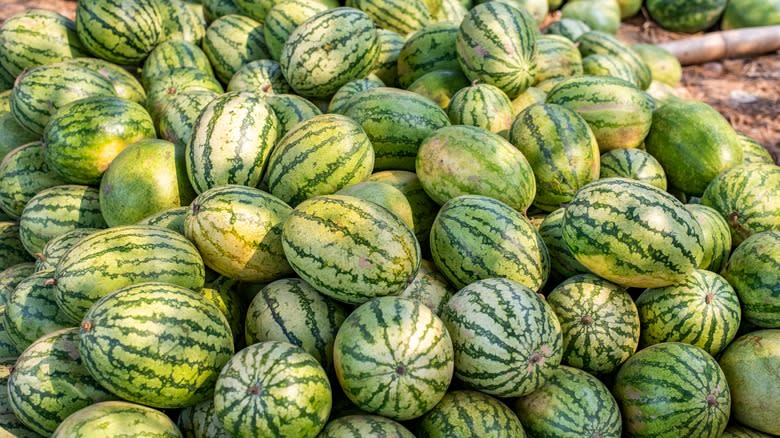
You can put all of your senses to use when selecting a ripe watermelon, and you should start with touch. Your hands may be the best tools for determining which melon to buy, and which ones you should leave at the store or farmer's market. You can simply touch a watermelon to tell if it's worthy of purchasing, as long as you know what to feel for. For the best chance at selecting a winner, your senses should be searching the melon for firmness.
The ideal watermelon will be firm when it's touched. How do you check a watermelon for firmness, you ask? Run your hands over the melon to make sure there are no soft spots on the skin. A soft spot means your melon is either diseased or overripe. Squeeze the melon gently. It should give slightly when pressed, but your fingers should not make an indentation. Pay special attention to the ends of the melon, especially the blossom end, opposite from the stem. When you press the blossom end gently, it should have some give to it like the rest of the melon. If it's soft, put the melon back in the pile, because it's likely overripe.
Tap And Listen
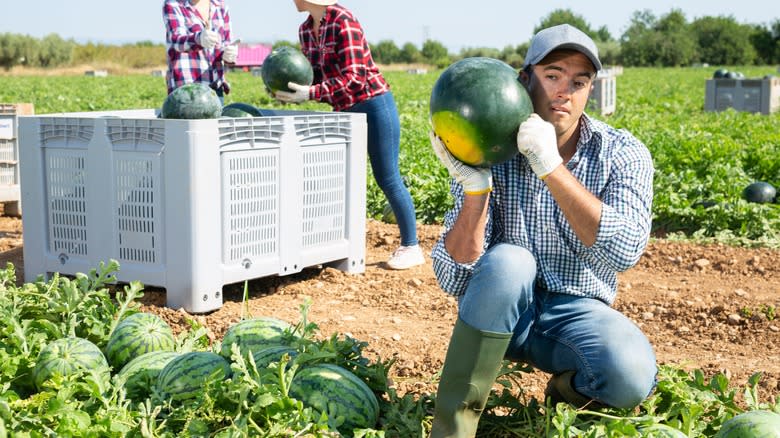
We've all seen shoppers in the produce section picking up watermelons and thumping them gently on the surface. Some tap the melons on top of the pile halfheartedly, while others lift the melon, holding it right next to their ear to listen intently as they thump it. If watermelon folklore is a thing, thumping a watermelon to see if it's the right one is canonical.
Knocking on a watermelon to test for ripeness may be common practice, but there is some debate about exactly what you should hear during your tap test. Most experts agree that a tap on a ripe watermelon will sound deep and hollow. Others believe only overripe melons will make a hollow sound.
There is consensus on what you should not hear when you tap a ripe watermelon. Melons that were allowed to become overly ripe will sound dull and flat when thumped, likely a sign that the melon's flesh has already begun to deteriorate. And avoid any watermelon that gives off a high-pitched sound when tapped. This is a clear indication that the watermelon is unripe.
Check The Watermelon's Stem
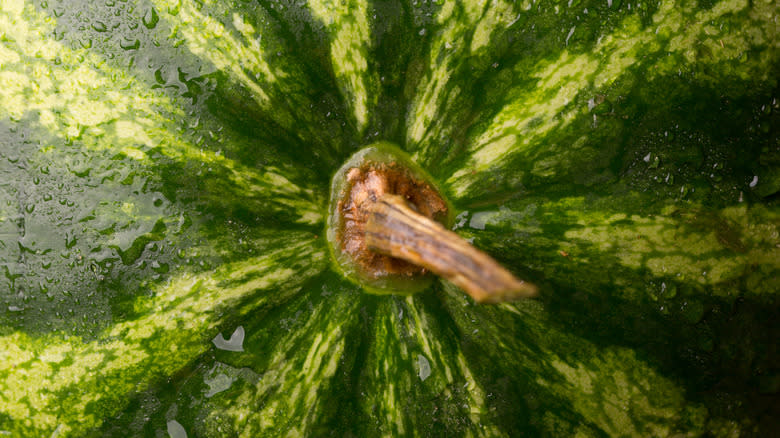
Green is often a sign of ripeness when it comes to produce. It's the color typically associated with nature and spring, when many fresh fruits and vegetables are at their peak. Watermelons are known for their green skin, but the color green is not a positive sign for one particular part of a watermelon — the stem.
Also called the tail, the stem of a watermelon is what connects the melon to the vine it's grown on. Stems provide water and nutrients to the melons as they grow. But keeping the growing watermelon nourished isn't a stem's only job. This part can also help you determine if your melon is ripe, so always pay attention to the tail of your watermelon before buying it.
A ripe watermelon should have a stem that is dry and yellowish-brown. This likely sounds like the opposite of a fruit that is fresh and ripe, but a dry, brown stem means that your watermelon was given plenty of time to ripen before it was plucked from the vine. Recently harvested watermelons with a bright green stem were most likely not allowed to fully ripen before being picked.
Sniff The Watermelon
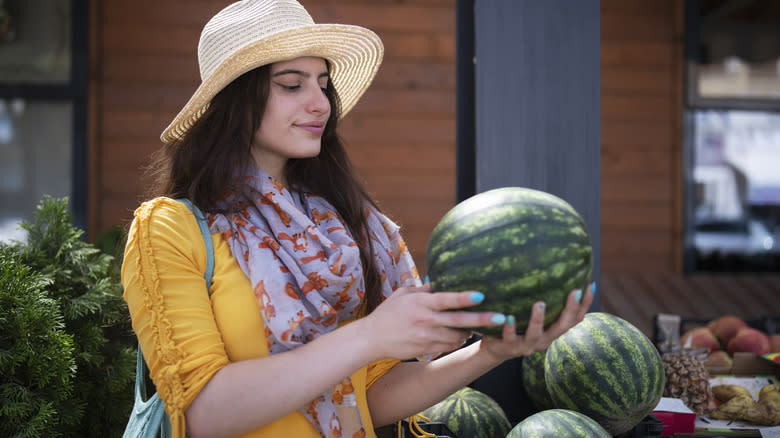
When it comes to choosing a ripe watermelon, your nose should know. We usually associate food smells with food that's spoiled, rotten, or past its prime, but aromas can also be a signal of something delicious, especially where watermelon is concerned.
Fruits generally develop a distinct aroma when they are fully ripe and ready to eat. A scientific study even found that certain fruits have evolved to have a stronger scent when they're ripe, in order to better attract the animals that eat them. When you're searching your produce section for a ripe watermelon, act like a hungry animal and use your nose.
Ripe watermelons have a wonderful, sweet smell that you should be able to detect through its rind. It should smell exactly how you want the watermelon to taste. To get the best whiff of your melon, sniff near the stem for best results. Avoid watermelon with no smell or a sweet smell that's too strong. A melon with an overwhelming or intense smell usually means that the fruit is past its prime, or overripe.
Check The Surface
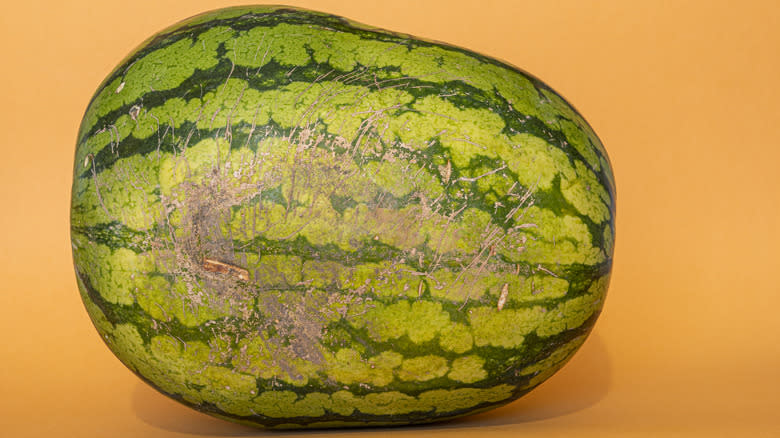
You should never judge a book by its cover, or a watermelon by its surface. When you're looking for a tasty, ripe watermelon, you might be tempted to choose the prettiest one you can find — but an attractive exterior does not equate to a flavorful interior.
Resist the temptation to choose a watermelon with the shiniest, bright-green rind. The longer a watermelon ripens, the duller the color becomes. So, while a vibrant green melon might seem like a smart choice, you should actually look for the opposite.
Besides a muted color, you should also check your watermelon for webbing. Also called sugar spots, webbing is the name for the rough, web-like brown lines often found on the surface of a melon, which sometimes look like cracks. It occurs when bees pollinate the flower of the watermelon as it grows. This pollination causes the webbing to develop. The more the watermelon flower is pollinated, the larger the sugar spots will become. Webbing on the rind is literal evidence of excess sugar seeping out of the melon. Examine your watermelon carefully and choose one with large sugar spots for the sweetest flesh.
Choose The Right Shape
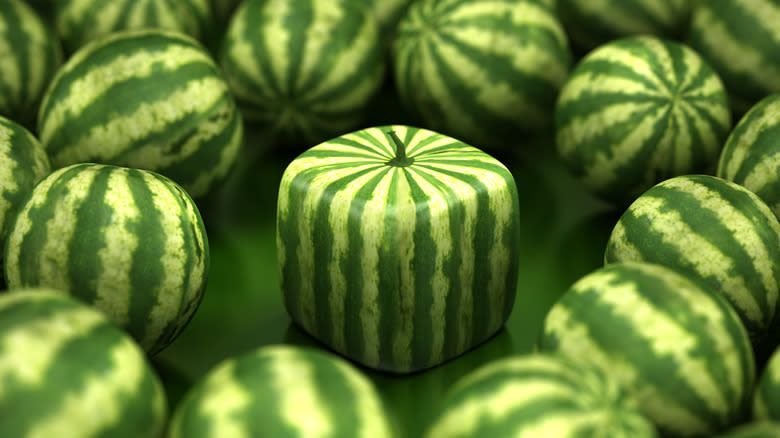
Watermelons come in a variety of shapes, most of which are some version of a circle or an oval. Smaller melons, like mini watermelons, are usually rounder in shape, while larger picnic melons bear the trademark oval shape. Whether your melon is round or oval, when choosing one that is ripe, the key thing to look for in terms of shape is symmetry.
When watermelons are shaped symmetrically, it means they received relatively equal amounts of sunshine and hydration as they grew. You don't need to pull out your tape measure to check a melon's form, but your melon should be relatively the same shape on all sides. When you come across melons that are unevenly shaped, or those with bumps that alter the shape in one spot, it's best to avoid purchasing them. Misshapen melons can be the result of improper pollination.
The rule of symmetry also applies to the rare square watermelon. Invented in the 1970s in Japan, square watermelons get their block-like shape by being grown in a square container.
Read the original article on Tasting Table.

 Yahoo Lifestyle
Yahoo Lifestyle 
